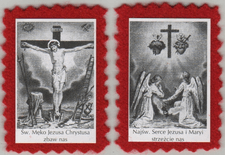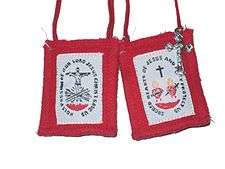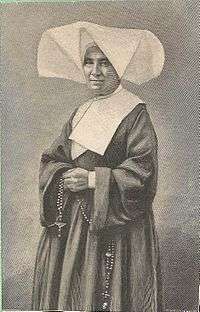Red Scapular of the Passion
The Red Scapular of the Passion of Our Lord and the Sacred Hearts of Jesus and Mary is a Roman Catholic sacramental scapular associated with the Lazarists. It is often just called the Scapular of the Passion or simply the Red Scapular but it should not be confused with other similarly-termed scapulars described below.[1] [2]


The Red Scapular of the Passion is a popular[3] scapular and forms the uppermost portion of the Fivefold Scapular.[1][4][5]
Origin
Apolline Andriveau
Louise-Apolline Andriveau was born on 7 May 1810 in Saint-Pourçain-sur-Sioule (Allier) to Leonardo, and Apolline Grangie Andriveau. Her father was a notary who saw to it that she received a good education. The family moved to Paris when her father received a promotion. Upon the death of her mother, it was decided that she should complete her studies at the convent of Saint Elizabeth.
In 1833, she joined the Daughters of Charity of Saint Vincent de Paul and was sent to the convent in Troyes. She had a particular devotion to the Passion of Christ. In 1830 Catherine Labouré had reported a vision of the Blessed Virgin, which she had experienced in the chapel of the motherhouse of the Daughters of Charity in Paris, which led to the development of the Miraculous Medal. Ten years later, in 1840, Sister Justine Bisqueyburu disclosed a vision of the Blessed Virgin she had purportedly experienced in the Daughters of Charity house in Blangy. This gave rise to the Green Scapular.

Sister Apolline revealed that from 26 July 1846 to 14 September 1846 visions of Jesus and Mary appeared to the sister in her convent in Troyes, France and promised her that those who wear the scapular faithfully and contemplated the Passion of Jesus Christ would be granted a great increase of faith, hope and charity every Friday.[2]
The sister described her visions as extremely specific and vivid. In letters to her spiritual director she wrote that Christ's face was so pale "that it threw me into a cold sweat. Our Lord's Head was bent forward. I thought that the long thorns that encircled His sacred Brow had induced this painful posture."[2] She also described a scene reminiscent of the Pietà:
One Sunday evening, I was making the Stations of the Cross...then at the Thirteenth Station, it seemed to me that Our Blessed Lady placed the Body of our Divine Lord in my arms, saying as she did so, "The world is drawing down ruin upon itself because it never thinks of the Passion of Jesus Christ. Do your utmost to bring it to meditate thereon, to bring about its salvation."[2]
In describing a vision on the eve of the octave of the Feast of St. Vincent (July 26, 1846) the nun described Christ:
...clad in a long red robe and blue mantle. Oh! Love of Jesus Christ, how You filled my heart at that moment! Oh! How beautiful He was! It was no longer the painful expression, the sorrowful face worn with suffering that I had seen in Pilate's hall a few days before during Mass. It was beauty itself! In his right Hand He held a scapular upon which was a crucifix surrounded by those instruments of the Passion which caused His Sacred Humanity to suffer most. I read around the crucifix: "Holy Passion of Our Lord Jesus Christ, save us." At the other end of the red woollen braid was a picture of the Sacred Hearts of Jesus and Mary, the one surrounded with thorns, the other pierced by a lance, and both surrounded by a cross.[2]
Sister Apolline described how she "shuddered" upon seeing Jesus "rudely struck against the wood of the cross" and quoted the Blessed Virgin Mary as saying that the "world is hurrying to its perdition because it considers not the Passion of Christ...Do all you can to bring and consider His sufferings. Do all you can to save the world."[2] According to the revelation claimed by Sister Apolline, to wear the blood-red scapular was to be "clad in the livery" of Christ's passion and that it "will prove to us a strong armor against infernal assaults, an impenetrable buckler against the arrows of our spiritual enemies and, according to the testimony of Jesus Christ, to all who wear it with faith and piety it will be a pledge of pardon, a source of grace."[2]
Sister Apolline also described a vision she received on the Feast of the Blessed Trinity in which she saw a beautiful river representing Christ's mercy in which those immersed glowed with bright light and "sheaves of diamonds and gold" while those refusing immersion "were covered with a dark vapor."[2]
The redemptive theme of the apparitions and its promises regarding the wearing of a sacramental featuring the Immaculate Heart of Mary are similar to two other Marian apparitions that took place in France earlier that century: the Miraculous Medal apparitions of 1830 and the Green Scapular apparitions of 1840.[2]
Approval
| Part of a series on |
| Scapulars of the Catholic Church |
|---|
Sacramental garments |
| General |
| Specific scapulars |
|
|
|
Sister Apolline's spiritual director, Father J. B. Etienne, made a trip to Rome the following year. The Holy See accepted the nun's claims with unusual alacrity and Blessed Pius IX sanctified and approved the use of this sacramental by a rescript on June 25, 1857. The pope granted various indulgences to the wearing of this scapular and granted to the Lazarists (priests of the Congregation of the Mission) the faculty of blessing the scapular and investing the faithful with it. The Superior-General of the Lazarists was allowed to communicate the faculty of blessing and investing the scapular to priests outside the Lazarist order [1] and such a scapular can now be invested by any Catholic priest.[4]
Promotion
In the United States of America, between 1953 and August 2008, the Red Scapular was officially promoted by the Marian Center operated by the Daughters of Charity of Saint Vincent de Paul (a branch of the same order to which Sister Appolline belonged).[6]
Description
The scapular and its bands must be made of red wool and unlike most scapulars it is adorned with specifically described images which are essential to it.[1]
One side of the scapular shows a crucifix, some of the Instruments of the Passion, and the words "Holy Passion of Our Lord Jesus Christ Save Us." The other side depicts a small cross above the Sacred Heart of Jesus and the Immaculate Heart of Mary plus the words "Sacred Hearts of Jesus and Mary, protect us."[1][3] In the example shown above right, a red segment representing the Precious Blood is placed below the two hearts, although other examples omit that non-essential element and include others, such as angels.[2]
Similar scapulars
The Red Scapular of the Passion described herein should not be confused with:
- The Black Scapular of the Passion associated with the Passionists
- The Red Scapular of the Most Precious Blood
- The White Scapular of the Sacred Hearts of Jesus and Mary associated with the Daughters of the Sacred Heart.
- The Scapular of the Sacred Heart based on the revelations claimed by Estelle Faguette at Pellevoisin
References
- Hilgers, Joseph. "Scapular." The Catholic Encyclopedia. Vol. 13. New York: Robert Appleton Company, 1912. 16 Nov. 2014
- The Red Scapular
- St. Michael Online Archived 2008-09-07 at the Wayback Machine
- Devotion to the Fivefold Scapular Archived 2008-09-05 at the Wayback Machine
- Fivefold Scapular
- Gifts of Graces, Archived 2011-06-26 at Archive.today, accessed 2 January 2012.